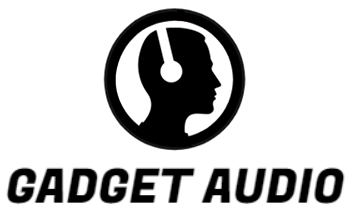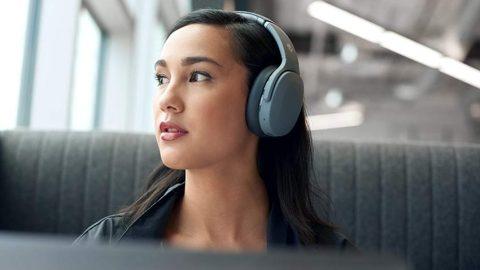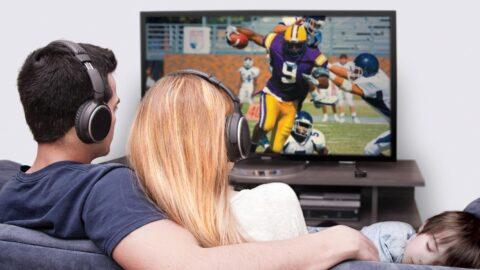12 Tips to Extend the Life of Your Headphones

In today’s world, we use headphones and earbuds for just about everything. We wear them to entertain ourselves and to communicate with one another.
If they stop working unexpectedly, you won’t be able to listen to music, movies, video games, podcasts, or hear phone calls. Do you ever ask yourself, why do my headphones keep breaking?
Fortunately, there are very effective ways to keep your headphones in good working condition. The key is to know how to protect them against risks that can cause damage.
Here are 12 helpful tips to show you how to extend the life of your headphones.
1. Keep Headphones Clean
Many people believe their headphones are permanently damaged because the audio quality has deteriorated significantly. When, in fact, all they need is proper maintenance. We recommend that you clean your headphones regularly, whether they are over-ear or on-ear headphones. Removing excessive grime away from your ears is not only a good idea for health reasons, but it may also improve the sound quality of your headphones.
The accumulation of earwax can diminish both volume and clarity. You can clean over-ear headphones in a variety of ways. Some headphones have ear cups and cables that are removable for cleaning. To get the most out of your headphones and keep them for years to come, make sure they are regularly cleaned and maintained.
How To Clean Your Headphones
Before you start cleaning, check the official manufacturer’s website for any additional instructions or procedures. You’ll need the following items to clean your headphones:
- A soft cloth
- Warm water
- Dish soap
- Isopropyl (rubbing) alcohol
- Hydrogen peroxide
- Old toothbrush
Using warm water and dish soap, dampen a soft cloth. Remove any detachable plastic tips or pads from your earbuds or headphones and clean them separately. You don’t want any liquid to get into the electronics. Wipe down each component, including the wires, with the cloth and allow it to dry completely. Scrub the mesh gently with an old toothbrush if there is a lot of grime on it. In those tight locations, mounting putty will help lift dirt. Repeat the process a few times. Low-concentration hydrogen peroxide or rubbing alcohol can also help loosen grime but use it sparingly and thoroughly dry afterward. For more tips, our guide on how to clean muffled earbuds explains everything you need to know.
2. Keep Headphones Dry
With today’s wide selection of water-resistant and waterproof headphones, it may seem that keeping them dry is not a concern. However, even the most water-resistant and waterproof headphones are capable of accumulating excessive moisture over time. If your headphones get wet or accumulate too much moisture, their internal components might become damaged and stop working.
What To Do If Your Headphones Get Wet
If your headphones become submerged in water, remove them as soon as possible. Any detachable parts, such as ear pads, foam, or silicone ear tips, should be taken off. Remove any excess water droplets by shaking your headphones. Dry them off as soon as possible using a moisture-absorbing towel or cloth. This immediate action can help prevent permanent damage to the headphones’ internal components.
You may need to open your headphones using a pry tool if any internal components come in contact with water.
Let it air dry for at least 24 hours before using it again. Use a can of compressed air to speed up the drying process and blow away the water droplets. Following these suggestions will help to speed up the process by allowing moisture in the circuitry to evaporate more quickly.
3. Keep Headphones From Extreme Temperatures
We’ve all been guilty of leaving our headphones inside of a parked car on a hot or cold day. Did you know that doing so can harm your headphones’ internal components? Headphone manufacturers recommend that you do not charge or store your headphones in extreme temperatures.
Low or high-temperature conditions can cause electronics to malfunction and permanently shorten the life of lithium-ion batteries. Use your headphones at an ambient temperature between 0º and 35º C (32º to 95º F).
How to Protect Headphones From Extra Temperatures
Here are some things to remember when it comes to protecting your headphones from extreme temperatures:
- Avoid charging your headphones in high or low temperatures.
- Do not leave headphones in direct sunlight for an extended time.
- Do not leave headphones in a car on a hot day.
- Use the correct charger for your headphones.
- Avoid extended hours of prolonged use.
4. Get Headphones That Fit Properly
We all have different head shapes and different preferences for what makes us feel comfortable. Some people prefer tight-fitting headphones that don’t slip off easily, while others prefer loose-fitting headphones that don’t press too hard against the ears. Whatever makes you feel comfortable, make sure the headphones you select fit your head shape. Headphones that are too small for your head are prone to bend and break. Headphones that are too big for your head, on the other hand, may slip off and break apart on the floor.
How to Choose Headphones That Fit
The following steps will help you get your headphones to fit properly:
- Avoid wearing headphones that are too big for your comfort and fit.
- Don’t wear headphones that are too small for your head shape.
- Wear headphones in the proper position, especially if you’re doing something active.
- To get the correct fit and better comfort, adjust the size of your headphones.
5. Don’t Travel Without a Case
We all want to take care of our brand-new headphones. With that in mind, one of the best ways to keep your headphones protected is to store them in a headphone carrying case. Incorrect handling and dropping are two of the most common causes of damage to headphones.
If you’re fortunate, the worst that can happen is that your headphones’ body and cable suffer a few scuffs and scratches. If you drop them on a hard surface, though, internal components may be damaged and malfunction. This is something you don’t want to happen, especially if you’re a serious audiophile with expensive headphones.
As a result, you should consider purchasing a case to protect your audio equipment from mishaps. In addition, cases do more than just protect your headphones. Some can charge your headphones while others have extra pockets for cords and more accessories.
How to Choose the Best Headphone Case For You
Here are a few things to consider before you choose a case for your headphones.
- Choose a case that is both compact and lightweight.
- If you’re active, consider a case that’s sturdy and has lots of padding.
- A case with a padded interior that is well-made is a must.
- Select a case with plenty of pockets and straps for storing your belongings.
- If you like to travel, consider a case that is waterproof or water-resistant.
6. Keep Headphone Cables From Breaking
Most people who want to listen to music on the go nowadays use wireless headphones and earbuds. On the other hand, others prefer wired headphones because they cost less, don’t require charging, and have better sound quality.
On the downside, wired headphones contain a cord that, if not carefully wrapped, might shorten the life of your headphones by several years. When the headphones aren’t in use, it’s a common mistake to quickly and carelessly wrap the cable. Cable wires are the most prone to breaking, and incorrect handling can cause them to break internally.
How To Wrap Headphone Cables So They Don’t Break
If you’ve been looking for a strategy to keep your headphones from tangling, then you’ve come to the right place. We’ve found the best method for wrapping headphone cables to avoid tangled knots. The best and simplest method to wrap headphone cables is as follows:
- Let the cable hang toward the floor.
- Wrap the cable in a circular loop.
- Twist every other circle in the opposite direction.
- Continue until the entire cord has been looped.
7. Don’t Pull on the Cable
Many people pull the cable on their wired headphones and earbuds to disconnect them from their phones, tablets, and computers. Some become oblivious to the fact that they are wearing them at all. As they walk away from their device, their headphones are ripped out of their ears. When you pull out your headphones in this way it puts a great deal of pressure on your input plug. As a result, frays along the wires may develop and your audio may stop working in one ear or both.
How to Detach Headphone Cables
The most secure method for detaching your headphones from your device is to:
- With one hand, grasp the earphone jack.
- Hold the device in place with your other hand.
- Remove the earphone jack from the smartphone with care.
8. Charge Wireless Headphones Regularly
You’re all set to listen to your favorite podcast when you realize your headphones’ battery is dead. You try to charge it, but it doesn’t work. Most people are unaware that if your headphone battery dies, replacing it yourself can be tricky. Headphone batteries are part of the device’s integrated design, making them difficult to access.
Did you know that keeping your headphones fully charged extends the life of the battery? If you’re worried about overcharging, don’t be. Lithium-ion batteries are unlikely to be overcharged. If you charge them before the battery dips below 20%, they’ll last the longest. You will considerably extend the battery life of your wireless headphones by doing so.
9. Don’t Sit on Your Headphones
Sitting on your headphones may seem like something you obviously shouldn’t do. However, over-ear headphones and earbuds get cracked or snapped quite often accidentally. This occurs when people place them in their back pocket or unintentionally lay heavy items on top of them.
How To Prevent Sitting On Your Headphones
Here are a few things you can do to keep your headphones from being crushed.
- Keep your headphones in a safe designated place
- Keep your headphones in a protective case
- Don’t keep your headphones in your back pocket
- Always look down before you sit near your devices
10. Avoid Falling Asleep With Headphones On
We’ve all dozed off while wearing headphones at some point. Not only can this disrupt your sleep, but the weight from your head (roughly 10-11 pounds) can snap the headband in half. In addition, turning and rolling in the bed can tug the cable and damage the ear cups by applying excess pressure.
The same holds if you forget that your headphones are on your head or in your ears while out and about running errands. This is another reason why headphones fall off our heads and go crashing to the ground.
Remember to take off your headphones before going to bed or running errands can save you from having to buy a new pair of expensive headphones.
11. Keep Track Of Your Headphones
Earbuds are a fantastic way to listen to a good playlist while on the go. They’re small enough to fit in your pocket, portable, and easy to take with you wherever you go. Unfortunately, they are just as easy to misplace. Over-ear headphones can also go missing, especially if you forget to put them back where they belong after each use. Someone else could pick them up and use them without your permission. If that happens, those nice headphones you spent a lot of money on could vanish forever.
How to Avoid Losing Headphones and Earbuds
Here are some things you can do to avoid losing your headphones:
- Have a designated spot to store headphones.
- Own more than one pair of earbuds to keep in different locations.
- Use an earbuds tracker.
- Keep earbuds in the case when you aren’t using them.
- Use over-ear headphones instead of earbuds.
- Retrace your steps.
12. Don’t Buy Cheap Headphones
When you’re in the market for a new pair of headphones, it’s easy to be tempted to buy the first pair you see on sale. However, it’s not a good idea to base your decision solely on price. Some models are very inexpensive but only appear to be well-made. Many are constructed with low-quality parts that are poorly assembled. If you don’t do your research, you’ll most likely end up with headphones that lack the features you require, as well as long-term durability. There are many budget-friendly models on the market with excellent durability and sound quality.
How To Choose The Best Headphones and Earbuds
Here are a few features to look for in headphones to ensure that you get the most out of them:
- Headphones with high sound quality.
- Headphones/or earbuds with a durable build.
- Headphones with reasonable battery life.
- Bluetooth headphones with the longest range.
- Headphones with a mic usable in wired and Bluetooth mode.
- Headphones with detachable cable with 3.5mm connector.
- Headphones with a folding design.
- Headphones with IP55 water resistance.






